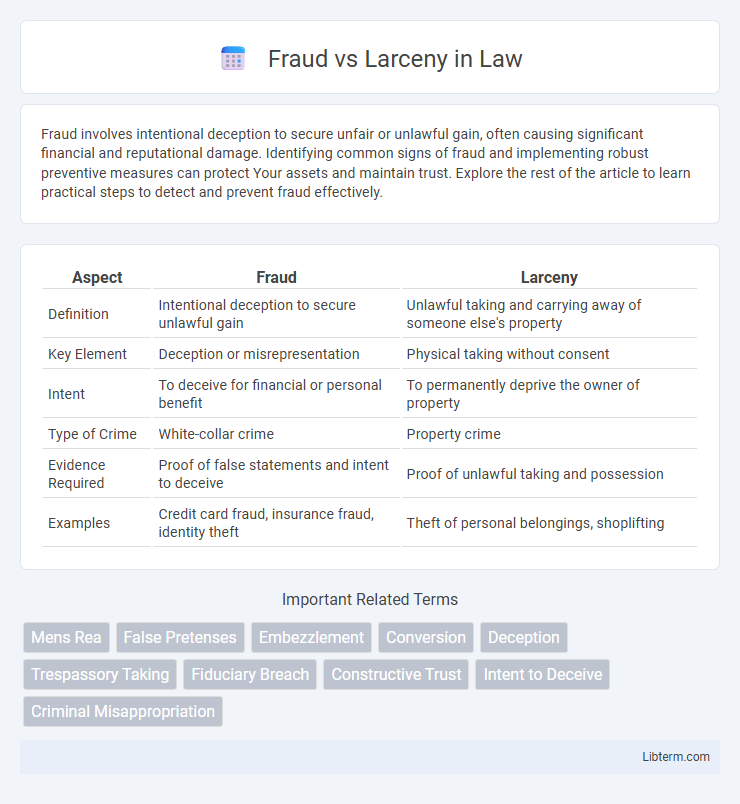Fraud involves intentional deception to secure unfair or unlawful gain, often causing significant financial and reputational damage. Identifying common signs of fraud and implementing robust preventive measures can protect Your assets and maintain trust. Explore the rest of the article to learn practical steps to detect and prevent fraud effectively.
Table of Comparison
| Aspect | Fraud | Larceny |
|---|---|---|
| Definition | Intentional deception to secure unlawful gain | Unlawful taking and carrying away of someone else's property |
| Key Element | Deception or misrepresentation | Physical taking without consent |
| Intent | To deceive for financial or personal benefit | To permanently deprive the owner of property |
| Type of Crime | White-collar crime | Property crime |
| Evidence Required | Proof of false statements and intent to deceive | Proof of unlawful taking and possession |
| Examples | Credit card fraud, insurance fraud, identity theft | Theft of personal belongings, shoplifting |
Understanding Fraud: Definition and Key Elements
Fraud involves intentional deception to secure unfair or unlawful financial gain, characterized by false representation, knowledge of its falsity, intent to deceive, reliance by the victim, and resulting damages. Unlike larceny, which is the unlawful taking of someone else's property without consent, fraud centers on deceitful conduct to manipulate or trick the victim. Key elements include misrepresentation, intent, reliance, and harm, making fraud a complex crime that extends beyond mere theft.
What is Larceny? Legal Meaning and Scope
Larceny is a legal term referring to the unlawful taking and carrying away of someone else's personal property with the intent to permanently deprive the owner of its possession. It is classified as a property crime under criminal law and involves tangible assets such as money, goods, or valuables. The scope of larceny covers acts like theft, shoplifting, and pickpocketing, distinguishing it from fraud, which involves deception to obtain financial or personal gain.
Comparing Intent: Fraud vs Larceny
Fraud involves intentionally deceiving another party to gain something of value, emphasizing deliberate misrepresentation or concealment of facts. Larceny centers on the unlawful taking and carrying away of someone else's property with the intent to permanently deprive the owner of it. The key distinction in intent lies in fraud's reliance on deceit to obtain consent, whereas larceny involves direct theft without the victim's consent.
Methods and Techniques Used in Fraud
Fraud involves deceptive methods such as identity theft, phishing, and financial statement manipulation to unlawfully obtain assets or benefits. Techniques like social engineering, false representations, and computer hacking facilitate the unauthorized acquisition of sensitive information or money. Larceny, in contrast, typically involves direct theft or physical taking of property without deception.
How Larceny is Committed: Common Examples
Larceny is typically committed through the unlawful taking and carrying away of someone else's personal property with the intent to permanently deprive the owner. Common examples include shoplifting, where individuals steal items from retail stores without paying, and pickpocketing, which involves stealthily removing wallets or valuables from a person's clothing or bags. Other frequent instances are burglary, involving breaking into homes to steal items, and car theft, where vehicles are taken without the owner's consent.
Legal Consequences: Fraud vs Larceny Penalties
Fraud penalties typically involve fines, restitution, and imprisonment, often reflecting the amount of money or property involved and the level of deceit used. Larceny penalties vary based on the value of stolen property, with petty larceny resulting in misdemeanor charges and grand larceny classified as a felony, leading to harsher sentences. Both offenses can result in long-term consequences such as criminal records, impacting future employment and legal rights.
Burden of Proof in Fraud and Larceny Cases
In fraud cases, the burden of proof requires the prosecution to demonstrate beyond a reasonable doubt that the defendant intentionally deceived another party to secure unlawful gain or cause loss. In larceny cases, the prosecution must prove beyond a reasonable doubt that the defendant unlawfully took and carried away someone else's property with the intent to permanently deprive the owner of it. The key distinction lies in the element of intentional deception for fraud versus the physical taking and carrying away of property for larceny.
Prevention Strategies: Reducing Fraud and Larceny
Implementing robust internal controls, such as segregation of duties and regular financial audits, significantly reduces the risk of both fraud and larceny. Employee training programs that emphasize ethical behavior and awareness of fraud indicators further enhance organizational defenses. Leveraging technology like advanced analytics and surveillance systems helps detect suspicious activities early and prevents financial losses.
Notable Real-World Cases: Fraud and Larceny
The Enron scandal exemplifies corporate fraud, involving the manipulation of financial statements to deceive investors and inflate stock prices, resulting in billions of dollars in losses and criminal indictments. In contrast, the case of Bernie Madoff highlights larceny, where Madoff orchestrated one of the largest Ponzi schemes in history, stealing approximately $65 billion from investors through false investment returns. Both cases underscore significant legal and financial repercussions, illustrating the distinct characteristics and impacts of fraud and larceny in real-world scenarios.
Fraud or Larceny: How to Identify the Difference
Fraud involves intentional deception to secure unfair or unlawful gain, often through false representation or concealment of information, whereas larceny refers to the unlawful taking of someone else's property with the intent to permanently deprive the owner. Identifying the difference hinges on recognizing that fraud exploits trust and misrepresentation, while larceny is a straightforward act of theft without deception. Legal distinctions emphasize intent and method, with fraud requiring proof of deceit and larceny focusing on the unauthorized taking of property.
Fraud Infographic

 libterm.com
libterm.com